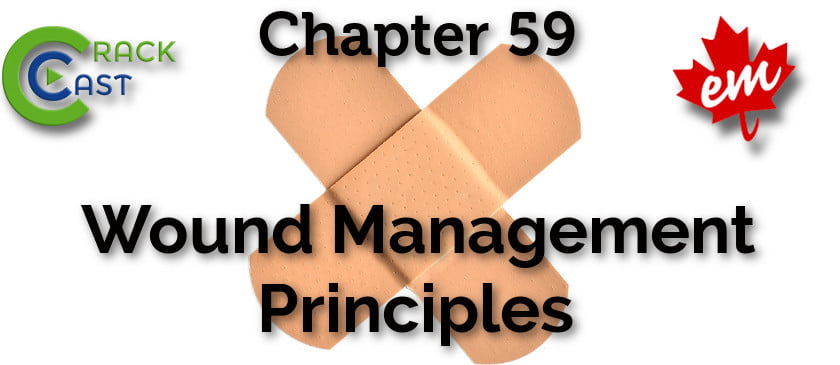This episode of CRACKCast covers Rosen’s Chapter 59, Wound Management Principles. This episode covers the nitty-gritty details of wound management and what you need to know to get that perfect wound closure!
Shownotes – PDF Here
[bg_faq_start]Rosen’s in Perspective
Infection risk is proportional to location, mechanism, host and care. Varies <1% to 20%.
Infection also affects ultimate scar outcome and wound related complaints are 4th most common cause of malpractice.
[bg_faq_end][bg_faq_start]1) List 8 risk factors for infection
- Injury > 8-12 hours old
- Locations with poor blood supply (Leg and thigh > arms > feet > chest > back > face > scalp)
- Contaminated wound
- Blunt mechanism
- Subcutaneous sutures
- Repair material (sutures > staples > tape)
- Anaesthesia with epi (really?)
- High-velocity Missile injuries
2) List 5 stages of wound healing
Coagulation (immediate)
- Standard cascade of intrinsic and extrinsic clotting factors culminating in platelet plug with fibrin crosslinking
Inflammation (immediate – 48 hours)
- Platelets release factors which encourage WBC migration into wound. Specifically Neutrophils and monocytes scavenge debris and bacteria
- Maturation of monocytes into macrophages promotes release of chemotactic substances triggering fibroblast replication and neovascularization
Collagen metabolism (>48 hours, peaks 7d, greatest mass 3wks)
- Fibroblasts synthesize and deposit collagen disordered collagen
- Requires oxygen
- Remodeling and cross linking continues for 6-12 months
Wound contraction
- Immediately skin retracts, when during next 3-4d wound length decreases independent of collagen
Epithelialization 48 hours – days
- Epithelial Cell migrate across wound, soon resembling uninjured skin
3) List the toxic dose local anaesthetics
- Silly naming %, not just giving concentration….1% lido = 10mg.ml (water is 1g/ml or 1000 mg/ml)
- Lido without epinephrine is 3-5mg/kg (max 35 ml 1% in 70kg), with epinephrine its 5-7 (max 49 ml 1% in 70 kg)
- Bupivicaine 2.5mg/kg without (25ml of 0.5% in 70kg) 3mg/kg with (max 42ml 0.5% in 70kg)
- Max intraoral = 90mg
The theory is that having epinephrine promotes vasoconstriction and reduces systemic absorption of the anesthetic
[bg_faq_end][bg_faq_start]4) List 3 types of wound closure
Primary
- Use in cases of clean wound, generally <8-12 hours (face up to 24 hours). Physician judgement is best method for deciding safety in wound closure. For guidance see Question 1
Delayed Primary Closure
- For wounds that meet risk factors from question 1 but require closure for satisfactory cosmetic outcomes (ie face, visible area)
- Typically not done in ED as requires primary packing, daily follow up and re-closure in 4-5d
Left Open
- Typically not seen in ED except in very dirty wounds or exceedingly small
- Rosen’s notes few studies looking at wounds <2cm, no difference in scar formation at 3 months
5) List advantages of and contraindications of tissue adhesives
Advantages:
- Quick, comfortable, no suture removal ,antibiotics properties, no risk of needle stick injuries, similar cosmetic outcomes
Disadvantages:
- Inability to use petrolium based products on the wound (ie. antibacterials), can’t use in high tension areas, can’t swim, must limit forces to glue, greater risk of dehiscence
6) List indications for tetanus immune prophylaxis
Caveat: * some sources say if wound is ‘dirty’ reduce to 5 years

7) List 5 specific wound care instructions

8) List 7 situations where antibiotic prophylaxis is indicated in wound management
- Cat bites – all. (Staphylococcus, streptococcus and Pasturella multocida). Amox clav (875mg x 7d)
- Dog bites – controversial. Guidelines say limit to hand, very dirty, older patients, deep puncture and immunocompromised. Amox clav x7d
- Fight bites – human bites or assumed to the hand. First thoroughly look for tendon or joint damage. Streptococcus, staphylococcus, eikenella corrodens and bacteroides. Amox Clav , plastic surgery consultant opinion
- Puncture wound of foot – no data supporting but should be considered especially in puncture through rubber shoe (pseudomonas). Ciproflox for pseudomonas, keflex for staph/strep. ?MRSA Septra or Doxycycline
- Delayed primary closure in high risk patients
- Open fractures
- High velocity missile wounds
Wise Cracks
[bg_faq_start]1) Evidence guided tips for scar healing
Silicone dressings?
- Cochrane: There is weak evidence of a benefit of silicone gel sheeting as a prevention for abnormal scarring in high-risk individuals but the poor quality of research means a great deal of uncertainty prevails. Trials evaluating silicone gel sheeting as a treatment for hypertrophic and keloid scarring showed improvements in scar thickness and scar colour but are of poor quality and highly susceptible to bias.
- Seems to be up to 12 months
Pressure/compression therapy
- Initial pressure dressing as soon as tolerated by patient
- Massage – our local plastics cite massage after first 1-2 weeks up to 6 months
Avoiding sun exposure up to a year – good evidence
No evidence for anything else including aloe, vitamin E,etc. Although good practice is probably keeping the skin hydrated
[bg_faq_end][bg_faq_start]2) How to decrease pain of anaesthetic injection?
- Buffering: 1:10 with lido (ie 1ml bicarb in 10 ml lidocaine) or 1:100 bupivacaine
- Inject through broken tissue – no increased risk of infection
- Smaller needle with low pressure
- ‘Jiggle’ skin
- Consider block for large area
- EMLA/cold spray/LET/Lidocaine prior to needle
- Inject slowly
- Bring local to skin temperature
3) Where can I find a concise guide to Suture material use?
Shout out to Dan Ting and Jared Baylis: published a guide to suture use with wonderful infographics at our host site CanadiEM.
Search google for CanadiEM sutures or see link here:
https://canadiem.org/nice-threads-guide-suture-choice-ed/
[bg_faq_end]This episode was edited and uploaded by Ross Prager (@ross_prager)


